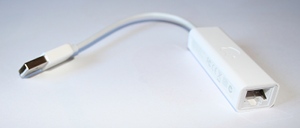USB 2.0 to Ethernet адаптер
Выбираю сабж, требования:
- работа в онтопике из коробки
- полностью свободный драйвер
- минимальные габаритные размеры
- светодиоды приветствуются
Спрашиваю, потому, что гугл не умеет в третий пункт.
Чем не подходит? http://ru.aliexpress.com/item/Hot-Sale-New-USB-2-0-Ethernet-10-100-Mbps-RJ45-.
И светодиод внутри корпуса есть, который горит красным при наличии линка и моргает при передаче данных.
А где именно светодиод? Мне нужен на одной грани с разъёмом.
Адаптер будет встроен в другой корпус, поэтому требование к габаритам.
Все приведённые выше модели довольно длинные, может быть бывают короче?
Только в большинстве случаев подобные адаптеры работают на 10мбит.
Впервые слышу, заказывал 10+ штук, все спокойно тянут 100FDX.
Только в большинстве случаев подобные адаптеры работают на 10мбит.
Источник
USB rj-45 сетевая карта без «установки драйверов»?
Попадались кому такие хвосты? Сетевая в мамке сдохла, свободных pci-e нет. Драйвера ставить не умею %)
Бывают (и давно) со всем необходимым уже в ядре.
Я сейчас бегло погуглил. На многое даже вендовозы жалуются, что оно дров хочет. И линупсисты тоже не все довольны.
Тема в надежде на то, что кто-то удачно купил и пользуется.
посмотри в исходниках ядра для каких есть
facepalm.png
Почему тогда не UCB?
берёшь ноут, идёшь в магазин, втыкаешь, смотришь dmesg, если определился, значит подходит
Какой dmesg, он вендоузятнег.
вот будет повод линукс поставить
Для Linux, наверное, все. Для шindows — на винфак.
ну или планшет с андроидом, там-то dmesg будет
Чтобы через неделю, не разобравшись в ситуации, стал опять поливать linux грязью?
С D-Link-ами внимательнее, под одним названием модели (хорошо, если с разным номером ревизии) могут продаваться железки на совсем разных чипах.
Про других пусть добавляют те, кто с подобным сталкивался.
Без рута на ведроиде dmesg не работает. По крайней мере у меня.
как будто что-то плохое.
пусть тогда воткнет и в диспетчере устройств смотрит.
dk- исправил бы и «адаптер», т.к. это полноценная usb-сетевая карта, давай уж правильно писать до конца.
«ходить в магазин»? ты с дубу рухнул? все привозят на место.
Это одна из 10-15 известных мне команд!
тогда заказывай 10-15 разных, какой-нибудь да заведётся
А я думал, наоборот. Один какой-нибудь из 10-15 не заведётся.
надо готовиться к худшему развитию событий! Если внезапно заведутся все, это будет приятным сюрпризом
По теме 2.0 USB-lan? Всё работает на всём, включая одноплатники, детсадовца позови, сделает.
Вендузятник должен страдать.
Брал какой-то кетайский, завелось из корбки. И бесчисленное множенство вай-фаев, в основлном нищебродские tp-link. Или ты про ферму и у тебя линукс?
Оно самое. Сетевка в мамке походу сдохла.
Чо там за чип? В левом нижнем углу, чуть ниже внешних разъемов сеть находится. Привози, благо соседи, махнем. С тебя пиво на майских
Воткнул и работает. В чём проблема-то?
Это те, что из соплей девственниц для лохов? В смысле, для успешных людей 😀
На многое даже вендовозы жалуются, что оно дров хочет.
Так с вендой дрова не распространяются, почти для любого железа качать надо отдельно.
Венда этому сама обучена, и конпелировать ничего не надо.
Брал два разных переходника от 5bites. Один usb 2.0 100mbit, другой — usb 3.0 1gbit с usb хабом. Оба заработали с полпинка, ещё в виртуалку прокидывал. Но насколько стабильно работают — хз, я максимум пару часов за раз использовал.
Внутри ASIX AX88179
Сетевухи с RTL8153B на Debian тоже с одного тычка заводятся и гигабит на USB3 выдают. Возможно usb-modeswitch понадобится, если сетевая как CD-ROM определяется.
чип или сам порт сломался? второе ведь можно перепаять.
да и первое тоже.
Самое чудное, что через пару часов после создания темы — все, сцуко, ожило и продолжило работать. Пока продолжаю наблюдения.
Многое насоветовали, и на реддите в теме были модельки конкретные, но оно все не продается локально тут «завтра привезут».
в целой Москве не нашлось одной usb-сетевухи, как страшно жыть, что санкции делают )
Источник
USB-Ethernet device for Linux
Useful device when you work with an embedded development board
For our Embedded Linux training sessions, I was looking for a USB to Ethernet device. Since Linux supported devices are often difficult to find, I’m glad to share my investigations here.
When you use an embedded development board, you must connect it to your computer with an Ethernet cable, for example to transfer a new kernel image to U-boot through tftp, or to make your board boot on a directory on your workstation, exported with NFS.
You could connect both the board and computer to your local network, which would still allow your computer to connect to the Internet while you work with the board. However, you may create conflicts on your local network if you don’t use DHCP to assign an IP address to your board (if your DHCP server even accepts this new device on the network). In a training environment, you are also likely to run out of Ethernet outlets in the training room if you have to connect 8 such boards. Hence, a direct connection between the board and your workstation’s Ethernet port is often the most convenient solution.
If you can’t use WIFI to keep your computer connected to the outside world, a good solution is to add an extra Ethernet port to your computer by using an USB-to-Ethernet device.
My colleague Thomas and I started looking for such devices that would be supported by Linux. Here are a few that we found:
- D-Link DUB-E100. Supported by the USB_NET_AX8817X driver. However, this product is bulky and quite heavy (at least 100 grams).
- TRENDnet TU2-E100. Supported by the same driver, but still bulk (August 2015 update: now replaced by a more recent version, now almost as small as the Apple one, and supported out of the box in Linux. See the comment about this device.)
- Linksys USB 200m. Supported by the same Linux driver and has a much more acceptable size, but customer reviews complain that its connector can break easily.
- Apple USB Ethernet Adapter. This should be working out of the box in Linux. At least the MB442Z/A or MC704ZM/A references did, but Apple now sells a new reference that might have a different chipset. It is beautiful, small and light. Support for this device (at least the references I mentioned) was added to Linux 2.6.26 through the same driver. You should be able to use it in recent distros.

I can’t tell whether this could happen with Apple. This was the first Apple device I ever bought…
Author: Michael Opdenacker
Michael Opdenacker is the founder of Bootlin, and was its CEO until 2021. He is best known for all the free embedded Linux and kernel training materials that he created together with Thomas Petazzoni. He is always looking for ways to increase performance, reduce size and boot time, and to maximize Linux’ world domination. More details. View all posts by Michael Opdenacker
41 thoughts on “USB-Ethernet device for Linux”
Yes, it is really nice.
Apple Store is also really efficient!!
A question: does u-boot support this device?
By looking at the source code, U-boot doesn’t. It’s true it would be a nice feature.
With U-Boot 2015.07 I was able to use USB Eth adapter (D-Link DUB-E100) with TFTP or NFS.
I own both the linksys and apple one and I must say that the linksys one is extremely flimsy and wider than a standard usb plug, so for ‘horizontal’ hub you loose 3 slots. The apple one is sturdy and only takes one usb slot in ‘horizontal’ hubs.
Good news. Apple accepted my “Perfect for Linux” comment (Webmaster note: page no longer available). Well, Apple may not see Linux as a direct threat as Microsoft does, but I didn’t expect them to accept Linux related comments on their websites.
I absolutely agree that Apple Ethernet adapter works very well under Linux (running on MIPS in our case). We’ve tested others, but none worked as well as Apple’s.
Is it necessary to connect the ethernet cable when I use an embedded board.
Not at all. Only when you need networking.
What is the best GigE USB adapter to use with Linux (RHLE 5.x)?
Will Linksys USB1000 work?
What I expected from the article titled “USB-Ethernet device for Linux” was using a USB port on the target device such as Mini-B/Mini-A that connects to a USB Series “A” plug on the Host machine using USB Gadget Support. This method ofcourse does not require the Apple USB to Ethernet converter and works well if the right config option is enabled in the target kernel along with the correct ifcfg-usb0 settings on the Host machine.
Right, this method can be used if your target has a USB device port. However, the USB to Ethernet converter has the advantage that it works in U-boot too. It is still rare that U-boot has USB gadget support.
I wanna use it for bare metal programming and also for busybox/ ARM-Linux.
According to the Amazon comments, this “Cubeternet USB 2.0 Hi-Speed Fast Ethernet Adapter for PC, Mac and Linux” device indeed works out of the box with Linux.
If you buy it, it would be nice if you could share the output of the lsusb command when it is plugged in. This way, we will know what chipset it has.
I’m working with a client right now on a system that uses a USB-to-Ethernet to add an additional interface to a Beagleboard Black.
We got one of these (lsusb says “ID 0b95:772b ASIX Electronics Corp.”), one of the “I/O Crest” dongles referenced below, and an Edimax (which just arrived today, so it hasn’t been tested yet).
I used socat to pump 10Mb chunks of data back and forth between the SBC and a desktop box for several hours. The I/O Crest ran clean, the Cubeternet had dozens of dropped packets.
This is, of course, a very crude test with a single exemplar of each type, so take it with several grains of salt. But my choice is to do the “final showdown” between the I/O Crest and the Edimax.
RE MB442Z/A
Hey Guys. I am not new but just not a guru by a long way. Is there a possible driver that will allow this adapter to be used on kernel 2.6.22-14 (Ubuntu 7.1) or am I going to have to get a later distro (8.04)?. I was given a IBM Think Pad 600x with 30 Gig hd which I would like to get running on line. It only has 1 USB and no ethernet.
The driver existed before 2.6.25 but didn’t declare this particular device. You could recompile your 2.6.22 kernel with the original patch (https://lkml.org/lkml/2008/5/13/470), and this should work.
Hi Mike.
In other words it would be best to get later version of Kubuntu and reinstall the whole thing. I am not set up for recompiling.
I know this article is old, but I wanted to say thanks for it. I needed a couple adapters for a multilink-PPP setup I am trying to do using an older Eee netbook. I decided to go the Apple route as there is a store close to me. To confirm, as of this date (Oct. 21, 2010), Apple is still using the ‘MB442Z/A’ part number and my Fedora 13 i386 install (2.6.35) worked perfectly, even at install time.
Thanks again for the info. I was about to go and buy an ITX system. 🙂
The MB442Z/A is being replaced with the MC704ZM/A, which is very similar but you can tell them apart because the corners of the USB are now more angular. Does anyone know if this new model is supported in current Linux kernel/distros?
As of today, they don’t seem to have the MB442Z/A in Cami stores in Belgium.
I sent my wife at the store as she was nearby. The sales girl insured that it was absolutely the same device and that it was working great 🙂
I said : “ask the girl the chipset reference then”.
My wife didn’t proceed 🙁
MC704ZM/A does not work when trying to install the latest Ubuntu 10.10
I hate engineers.
Have anyone comfirmed that the chipset have changed from MB442Z/A to MC704ZM/A?
If so, what did it change into?
Thank you for the valuable info!
Does anybody know if the D-Link DUB E-100 works with the Popcorn Hour C-200 Networked Media Tank?
Do any of the above?
I can confirm the newer MC704ZM/A is still using the same chipset, and USB device IDs. Plugged it into an Ubuntu 10.10 box and it recognized it right away.
To help out others who are struggling to get this working I did the following to get a bunch of USB ethernet cards (Apple, Sabrent 10/100/1000 Mbps and Plugable 10/100/1000) to work:
1) unplug the USB ethernet dongle
2) at the command prompt –>uname -r
3) go to http://www.asix.com.tw/ and download the appropriate driver for the version that shows from the uname -r. I an running Ubuntu 10.10 with kernel 2.6.38-10-generic which is considered 2.6.38.
4) make sure you have kernel headers downloaded for your kernel. Search around for
5) After unzipping and untaring at the command prompt enter –>make
6) then enter at the command prompt –>make install
plug the dongle back in. If you have a cable plugged in, bonus. You should see Ubuntu auto detect the dongle and update the network icon at the top right. You can then connect to the internet to verify.
This article and its comments were very helpful; thanks!
Источник





















